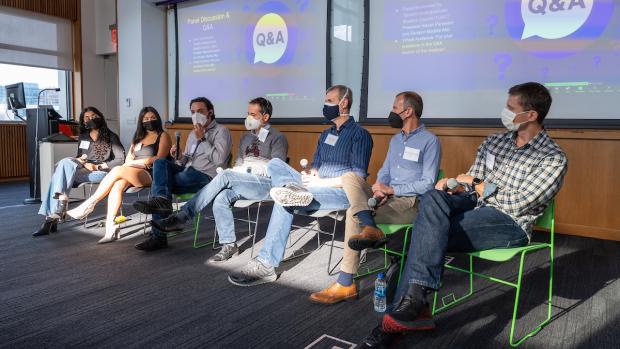Engineering safer cities: Panelists discuss how to tackle America's firearm ecosystem

Panelists discussed the American firearm ecosystem, the complex system that feeds gun violence across the country.
Tandon students are known for their commitment to improving the world, and when they began asking how engineers could contribute to the vital national discussion of gun violence, it sparked plans for a high-profile technical talk and panel event that convened in Brooklyn on September 12 under the auspices of the school’s Center for Urban Science + Progress.
Panelists included:
- NYU Tandon Institute Professor Maurizio Porfiri
- NYU Tandon Professor Oded Nov
- UCLA Professor James Macinko
- Georgia State University Professor Igor Belykh
- Northeastern University Professor Rifat Sipahi
Each panelist delivered a flash technical talk sharing their research, followed by a panel moderated by NYU Tandon Undergraduate Student Council President Nawal Panjwani and NYU Tandon Student Council Senator Madeleine Mai.
The members of the group had one important thing in common: a drive to better understand the American firearm ecosystem — a complex system that involves firearm prevalence, legislation, media coverage, socioeconomic factors, political affairs, and social phenomena.
Each of the speakers is a principal investigator on a multipronged research project, “Understanding and Engineering the Ecosystem of Firearms: Prevalence, Safety, and Firearm-Related Harms,” which is being funded by the National Science Foundation’s LEAP HI initiative (Leading Engineering for America's Prosperity, Health, and Infrastructure). LEAP HI projects address engineering problems that are too complex to yield to the efforts of a single investigator — problems that require sustained and coordinated effort from interdisciplinary research teams.
The panelists explained that they were tackling their work on three levels: the macroscale, by examining causality between firearm prevalence and firearm-related harms at the national level; the mesoscale, by studying policy diffusion across states; and the microscale, which involves individual opinions about firearm safety.
During their presentations, the investigators detailed each of the research questions they are seeking to answer, including what formative factors lead to firearm acquisition and what roles legislation and the media play; whether public opinion has a causal role in how firearms spread through urban areas; where social media and disinformation fit in; and what states can and do learn from one another.
Their findings thus far have held some surprises: Porfiri and his team, for example, questioned the reasons people decide to purchase a gun after a mass shooting; applying a data science methodology to infer causal relationships, they discovered that such purchases were driven more by a fear of stricter government regulations on ownership than by a desire to protect oneself from a shooter, as might be assumed.
The event was co-sponsored by the Undergraduate and Graduate Student Councils, and following the presentations, student moderators Nawal Panjwani and Madeleine Mai peppered the panel with thoughtful questions: How can states maintain public safety without increased accessibility to firearms? Is boosting police presence in urban public transit systems an effective way to curb mass violence or could that money be better spent on other efforts?
With guns now taking more lives in the U.S. per year than motor vehicle accidents, the panelists agreed that evidence-based scientific research like that which they’re conducting is needed more than ever before to answer questions like these.

